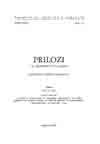Društveno-istorijska uslovljenost Džahizovog djela Kitāb al-buhalā'
Kitāb al-buhalā' (Book of misers)
Author(s): Aiša Đulizarević-SimićSubject(s): Literary Texts
Published by: Orijentalni Institut u Sarajevu
Summary/Abstract: Kitāb al-buhalā' (Book of Misers), the work of one of the greatest writers in Arabic literature Amr ibn Bahr al-Gahiz, in addition to its literary and artistic value, has a special significance as a source for the study of social conditions in Islamic society at the end of the eighth and in the first half of the ninth centuries. The fact that in Gahiz's time the process of assimilation of cultures brought about a rivalry between the Arabs and the Persians and that Gahiz was famous as a spokesman of the Arab cause, gave rise to the opinions that in this work he stigmatizes the miserliness of the Persians and extols the generosity of the Arabs. True, one cannot seriously object to these opinions because his other works also speak of him as a defender of the Arabs. The focus of this article is, however, on considering the work in the context of another important moment of Gahiz.'s time- the rise of the bourgeoisie and accumulation of capital. The information that Kitāb al-buhalā' ·offers about this phenomenon, as well as about the morality of Islamic society of that time, points to the necessity of questioning the opinions held so far concerning this problem as well as the historical development of the Islamic world in general. The article emphasizes the importance of this information, in which connection the problem of the study of the social history of the Islamic world and of perceiving the relationship in Islam between ideology and practice has only marginally been posited. In this, in our opinion, Maxime Rodinson's judgement can show the way. Finally, a few observations have been offered concerning the comparison of Gahiz's work with Plautus' Aulularia, Moliere's Miser, and Kir Janja by Jovan Sterija Popović. These observations are reduced to pointing out the ·similarities as well as the differences regarding social causality of these respective works.
Journal: Prilozi za orijentalnu filologiju
- Issue Year: 1976
- Issue No: 22-23
- Page Range: 257-267
- Page Count: 11
- Language: Bosnian

